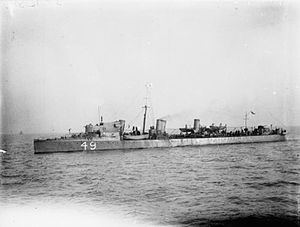Name HMS Kestrel Commissioned April 1900 Launched 25 March 1897 | Laid down 2 September 1896 Construction started 2 September 1896 Builder John Brown & Company | |
 | ||
Ordered 1896 – 1897 Naval Estimates Out of service Laid up in reserve 1919 Fate 17 March 1921 sold to Thos W Ward of Sheffeild for breaking at Rainham, Kent | ||
HMS Kestrel was a Clydebank-built three funnelled 30-knot destroyer ordered by the Royal Navy under the 1895 – 1896 Naval Estimates. She was the fourth ship to carry this name since it was first used in 1846 for a brigantine.
Contents
In 1913 she was grouped with similar vessels as a C-class destroyer.
Construction
She was laid down as Yard Number 298 on 2 September 1896 at J & G Thompson shipyard in Clydebank and launched on 25 March 1898. During her builder’s trials she made her contract speed of 30 knots. In 1899 during the construction of these ships, steelmaker John Brown and Company of Sheffield bought J&G Thomson's Clydebank yard. She was completed and accepted by the Royal Navy in April 1900.
Pre-War
After commissioning she was assigned to the Chatham Division of the Harwich Flotilla. She was deployed in Home waters for her entire service life.
On 7 August 1907 Kestrel and the River-class destroyer Teviot collided off Swanage, with Kestrel's bow being cut off in the collision. Kestrel was brought into Portsmouth Dockyard for repair, where, such was the number of Royal Navy ships requiring repair after recent incidents, only one dock was available to receive Kestrel, and which was only able to accommodate the damaged destroyer because she had lost her bow, as Kestrel was otherwise too long to fit in the dock.
On 30 August 1912 the Admiralty directed all destroyer classes were to be designated by letters. Since her design speed was 30-knots and she had three funnels she was assigned to the C Class. After 30 September 1913, she was known as a C Class destroyer and had the letter ‘C’ painted on the hull below the bridge area and on either the fore or aft funnel.
World War I
In 1914 she was in active commission at the Nore based at Sheerness tendered to HMS Actaeon, a Royal Navy training establishment. With the outbreak of hostilities in August 1914 she was assigned to the Nore Local Flotilla. Her duties included anti-submarine and counter mining patrols in the Thames Estuary.
Disposition
In 1919 she was paid off and laid-up in reserve awaiting disposal. She was sold on 17 March 1921 to Thos W Ward of Sheffield for breaking at Rainham, Kent on the Thames Estuary.
She was not awarded a battle honour for her service.
